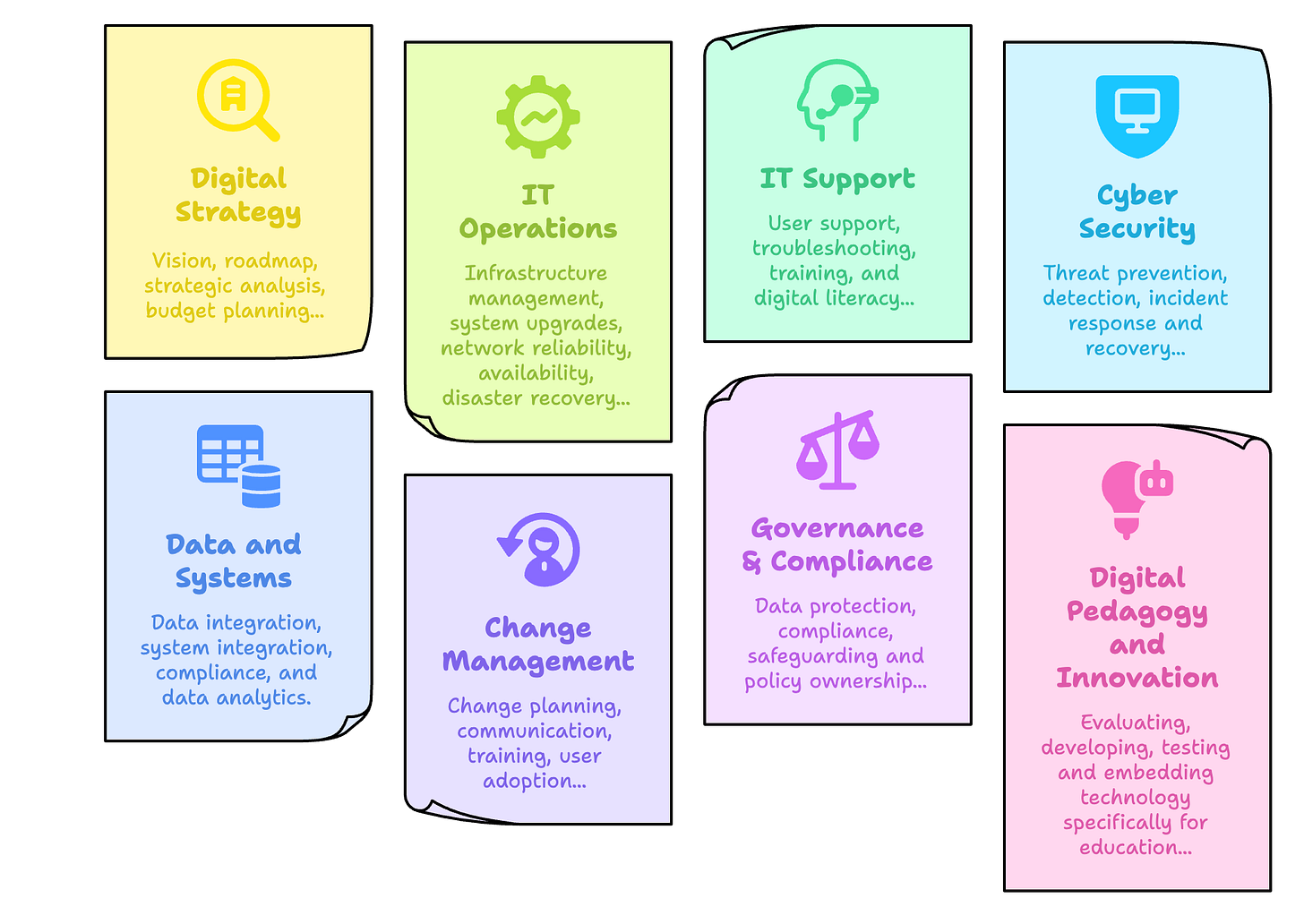IT & Digital Capabilities in Education
With the end of support for Windows 10 looming, many schools are in exactly the same place they were with Windows 7, and Windows XP. Why?
We’re fast approaching the deadline for the end of support for Microsoft Windows 10 (14th October 2025) and, judging by the voices of colleagues in and across the UK, many are in precisely the same position that they were at the end of support for Windows 7 and Windows XP. A large number of schools aren’t ready, and many only began properly planning their upgrade paths in the last 6 months. So why are we here, again?
The answer is both quite simple, and rather complicated. Like many things, we need the complexity first before we can simplify, so let’s start there…
Missing capabilities…
If we listed the high-level capabilities that a Multi-Academy Trust needs within the digital realm, it might look something like this…
In many trusts, if you were to document their current capabilities in the digital realm, it would look something like this…
Many IT teams in schools and trusts know that there’s much more to their world than IT support, but are overwhelmed by a seemingly endless support workload. Educators and leadership teams can often sense the gap in proactive efforts but, in my experience, don’t have a clear understanding of what better would look like.
Matt Setchell wrote recently that “the structure of IT Support in Education needs to change“. The post is excellent and, as Matt rightly points out, there are several separate skillsets and disciplines at play here. The mindset shift from supporting nervous or stressed staff and managing IT infrastructure is significant, and not many people truly excel at both.
With this in mind, let’s look at the simple answer…
A challenge for Leadership…
For me, our sector’s struggle with technology boils down to one question, and it’s the same one that I raised in my last post on cyber security:
Can we prioritise important work that few will notice, over urgent work demanded by many?
Getting this right is something that can only be done through leadership. Leaders create the culture and the space in which important work is either sponsored, prioritised and recognised, or crowded out and forgotten until it’s too late. However, it’s not easy.
To ensure that important security upgrades are applied, or funds are available to upgrade core infrastructure, we have to protect the time, people and budgets required to make it happen. All three of those resources are under pressure. Many of the alternatives on which they could be spent will be laudable, and the emotional case for doing so will often be powerful. For me, this is why it’s important to understand that the capabilities I’ve outlined earlier in this post, and the disciplines that Matt describes, are distinct.
If we were to redeploy all of our English teachers to the Maths department and ask them to teach additional Maths lessons, our students would (at best) get slightly better results. Meanwhile, our English results would plummet, and the intervention required in future years to redress our mistake would be considerable.
For technology to empower a school or trust, it takes an awful lot more than excellent support. In fact, exemplary user experience and support services are built on the other capabilities - without them our IT staff will just be fighting fires that spread faster than they can be extinguished.
A path forwards…
The first step is to understand that there’s an awful lot more to technology than IT support, and to identify and articulate the gaps in our organisation. Then we must address these gaps whilst remaining cognisant of the current support efforts required to keep our organisation running. To extend the fire-fighting metaphor - if the whole town is on fire, it’s no good withdrawing the fire service and simply saying “it’ll be better in 12 months time once we’ve rebuilt it out of something better”. Instead, we need to find the balance between solving pressing immediate issues and building for a much better future. The more we are able to show people a path forwards that they believe in, the more they’ll help us along the way.
In many schools and trusts, IT, technology and data don’t have a proper seat at the table and the kind of transition above only occurs as a result of some crisis or other. That difficult period of just about managing can last years, but knowing that your organisation’s digital estate is tinderbox-dry and ready to combust at the slightest excuse is no way to live.
To my colleagues in technical roles who can see the gap but need support from leadership to start making a change, take agency. It’s not fair for us to bemoan our lack of voice if we never actually speak. Take the time to understand the school and trust in which you work, and show how your suggestions help students, staff, and the school as a whole.
To my colleagues in leadership or education roles who can see that their technical teams are struggling to stay afloat, but perhaps haven’t encountered the concepts I’ve outlined in this post, use them to start asking your team how you can help. Be patient with them - techies are easily spooked, and you might have to build some space and trust with them first.



